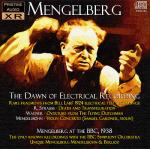「Pt.0 (はじめに)」、そして「Pt.1 (定速度と定振幅、電気録音黎明期)」の続きです。
This article is a sequel to “Things I learned on Phono EQ curves, Pt.0” and “Things I learned on Phono EQ curves, Pt.1”.
前回 は、いろいろ脱線しながら(笑)レコードに記録される2つの特性と、電気録音黎明期のあれこれについて調べました。今回は、EQカーブの話を離れて、電気録音黎明期のあれこれ についてもう少し調べていきます。
On the previous part, I studied on two recording characteristics (constant velocity and constant amplitude), as well as the history of Electrical Recording in its very early years, along with several digressions… This time, I am going to continue learning other things during the early days of electrical recording, apart from EQ curves.
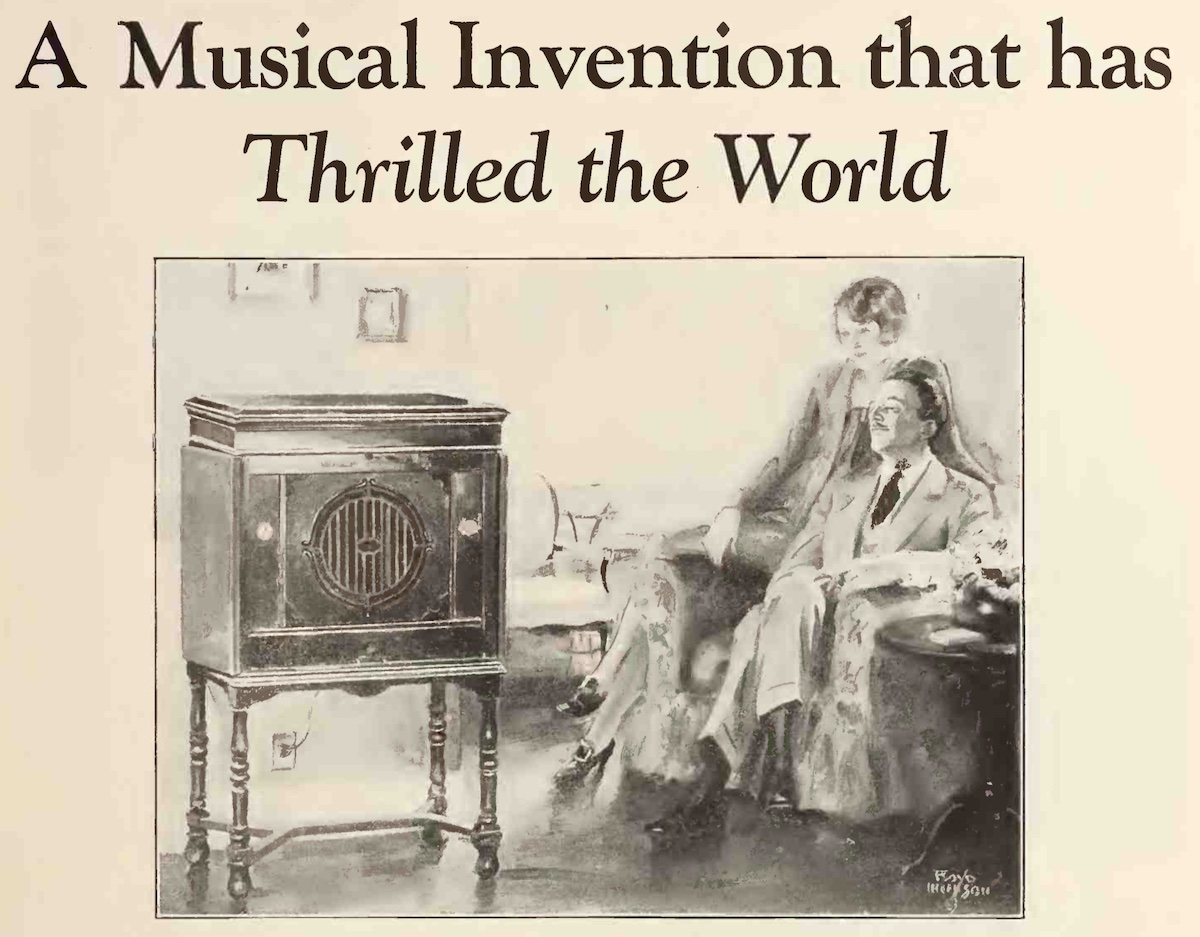
source: Brunswick Panatrope Ad on “The Talking Machine World, February 15, 1927”, p.5.
前回も書きましたが、筆者自身の学習過程を記したものですので、間違いの指摘や異論は遠慮なくお寄せください。
As I noted in the previous article, this is the footsteps of my own learning process, so please let me know if you find any mistakes on my article(s) / if you have different opinions.
今回も相当長い文章になってしまいましたので、さきに要約を掲載します。同じ内容は最後の まとめ にも掲載しています。
Again, this article become very lengthy – so here is the summary of this article (the same contents are avilable also in the the summary subsection).
1920年におそらく世界初とされる実験的電気録音がロンドンで行われていた。その音源は今でも聴くことができる。
In 1920, probably the world’s first experiment of electrical recording was conducted in London. The recorded sound still exists, and can be heard on YouTube for example.
独自の Light-Ray / Palatrope 録音システムを開発した Brunswick が自社レーベルに使い始めたが、ほどなくフェードアウトし、Bell Labs / Western Electric のラバーライン録音システムに変更された。
Brunswick developed the unique Light-Ray / Palatrope recording system, and used for their own commercial discs, but after a few years it was replaced by the Bell Labs / Western Electric Rubber-Line recording system.
1919年に始まった民間ラジオ放送は、周波数帯域は当時のレコードより優れており、また受信機も非常に安価だったため、レコードや蓄音機の売り上げは落ち、各メーカやレーベルは受難の時期を過ごした。その危機感から生まれたのが電気録音であった。また、蓄音機メーカはラジオ受信機を合体させることで売上減に少しでも対処しようとしていた。
Commercial radio broadcast in 1919 changed everything, including the decline of record/player sales. Radio had much better frequency range, and the receiver equipments were much cheaper than the phonograph players. Phonograph companies and record labels tried to survive these tough years. The invention of Electrical disc recording could be one of them. Many phonograph makers added radio receiver unit into the phonograph player system, in order to cope with the sales decline.
Contents / 目次
- 2.1 Earliest Electrical Recordings / 最初期の電気録音
- 2.1.1 World’s First Patent about Electrical Recording (1919) / 世界初の電気録音絡みの特許 (1919)
- 2.1.2 World’s First Electrical Recording (1920) / 世界初の電気録音 (1920)
- 2.1.3 Bell Labs’ Experimental Electrical Recordings (1924) / ベル研の実験的電気録音 (1924)
- 2.1.4 Columbia’s First Commercial Electrical Recording (1925) / Columbia の市販用初電気録音 (1925)
- 2.1.5 Victor’s First Issued Commercial Electric Recording (1925) / Victor の最初に市販された電気録音
- 2.2 World’s First Electric Phonograph Player / 世界初の電蓄
- 2.3 “Light-Ray” Electrical Recording Method / Light-Ray 電気録音
- 2.4 Rival forms of media: Radio & Phonograph / ラジオとレコード、メディアの競合
- 2.5 The summary of what I got this time / 自分なりのまとめ
2.1 Earliest Electrical Recordings / 最初期の電気録音
ここからは、EQカーブの話を離れて、少し余談になります。
An additional digression here, other than the EQ curves…
前回 (Pt.1) は、Bell Labs / Western Electric の「ラバーラインレコーダ」による電気録音技術について調べてみました。で、それが世界初の電気録音だったかというと、それ以前にも実験的なものはあったようですし、最初にリリースされた電気録音は何かも気になりますので、みていきましょう。
On previous part (Pt.1) of my article, I learned the very early electrical recording technology and system, so-called “rubber-line recorder” developed by Bell Labs and Western Electric. However, it was not the world’s first electrical recording. Also, it is interesting to know which electrical recording was firstly released. Let’s take a look at the experimental recording conducted earlier than the rubber-line recording system below.
以下のリンク先のページを参考にしています。
Info from the below link “First sound recording”.
2.1.1 World’s First Patent about Electrical Recording (1919) / 世界初の電気録音絡みの特許 (1919)
American Telephone and Telegraph Company、通称 AT&T の L. Espenschied 氏が1919年11月に特許申請し、1929年5月に登録された 1,713,039 が、電気録音の最初期の例ということになりそうです。
It seems like the US Patent 1,713,039 is the first patent about electrical recording, filed on November 15, 1919 (then application granted / published on May 14, 1929). The inventor was Lloyd Espenschied of American Telephone and Telegraph Company (AT&T).
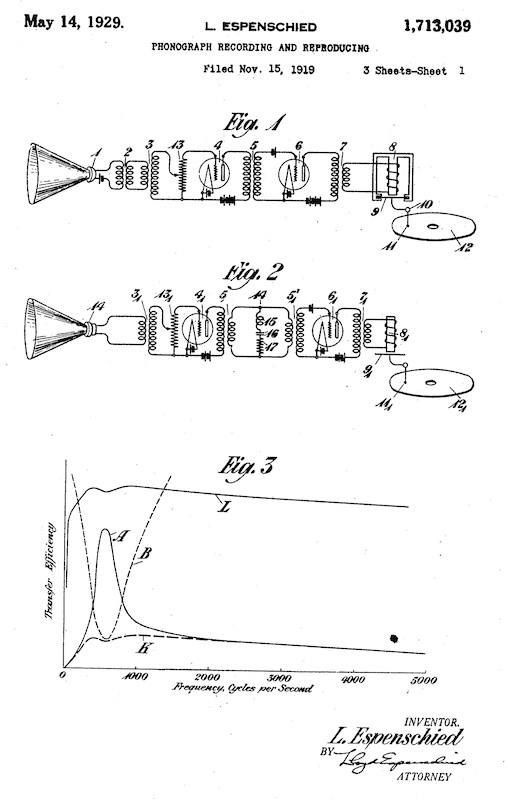
source: “Phonograph Recording and Reproducing”, US Patent 1,713,039, by Lloyd Espenschied.
恐らく世界初の電気録音に関する特許に登場する図版
2.1.2 World’s First Electrical Recording (1920) / 世界初の電気録音 (1920)
1919年、一説によると1916年から研究が行われていた電気録音についてですが、販売目的の世界初とされる例はなんと、1920年11月11日 までに遡るとのことです。
Experiments with electrical recording started in 1919, or even in 1916, and the world’s first Electrical recording (aimed to sell public) known to exist was conducted as early as November 11, 1920!
Columbia のエンジニア Lionel Guest と Horace O. Merriman によって開発された実験的電気録音システムによって、ロンドンのウエストミンスター寺院で2枚の録音が行われたそうです。しかし、当時のマイクの技術の低さもあって、録音品質は非常に悪く、当時のアコースティック録音にも劣るため、この録音システムは以後使われることはなかったとのことです。“The Illustrated London News 1920年12月18日号” に、その時のイラスト記事が掲載されています。
The experimental recording system was developed by Columbia’s sound engineers Lionel Guest and Horace O. Merriman, and the recording was made at Westminster Abbey, London. However, in the absence of better microphones, the recording quality was not satisfactory – inferior to the acoustical recording – so Columbia decided not to adopt the Guest-Merriman system. The illustrated article was appeared on “The Illustrated London News, Dec. 18, 1920”.
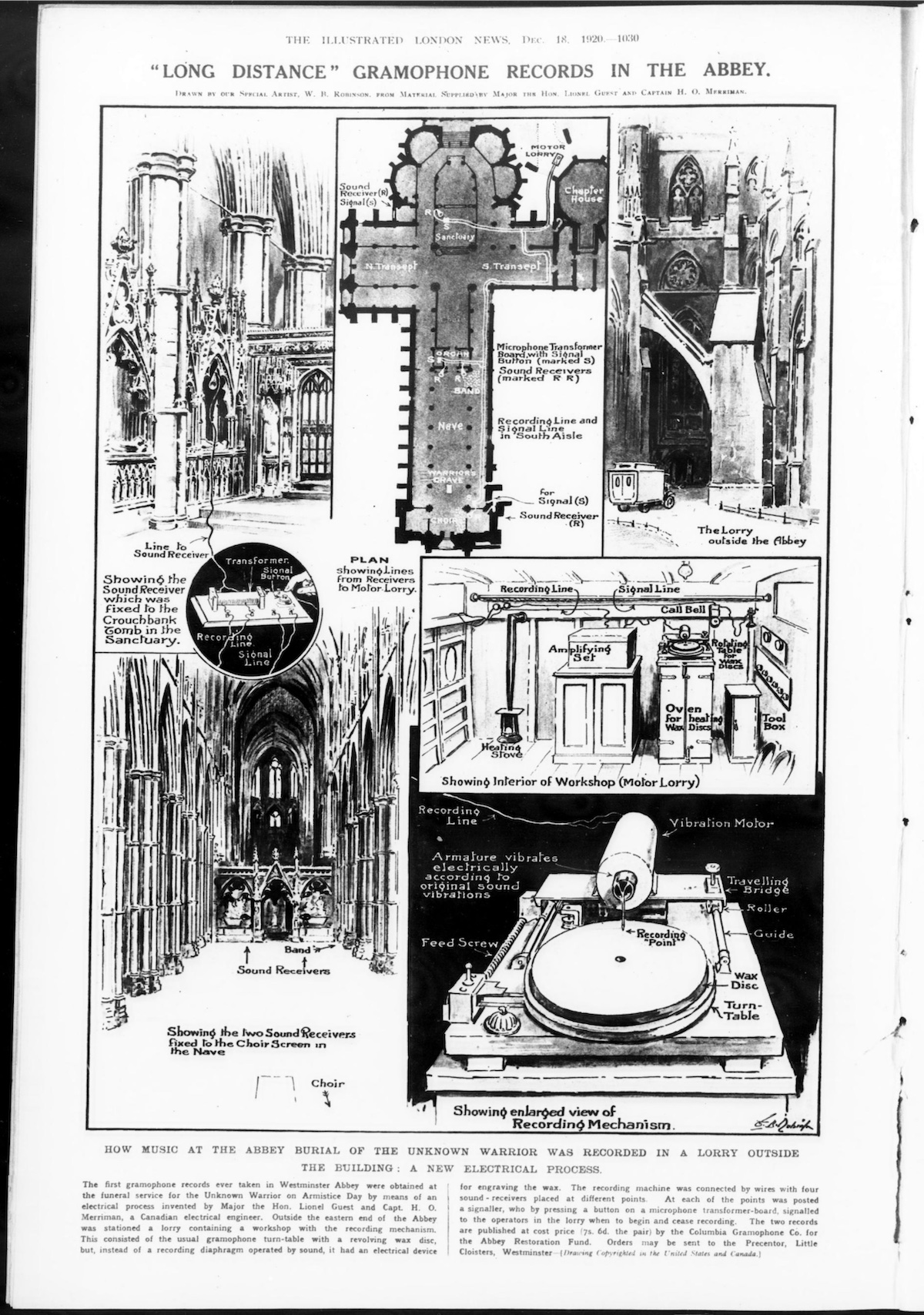
source: ““Long Distance Gramophone Records In The Abbey””, The Illustrated London News, Vol. 157, No. 4261, p.1030, Dec. 18, 1926
世界初の電気録音の模様をイラストで伝える記事
“…The first gramophone records ever taken in Westminster Abbey were obtained at the funeral service for the Unknown Warrior on Armistice Day by means of an electrical process invented by Major the Hon. Lionel Guest and Capt. H.O. Marriman, a Canadian electrical engineer. …”
また、以下のwebページにも詳しい説明があるほか、その 1920年11月11日録音、世界初電気録音の音源 を聞くことができます。
The below webpage also has detailed description of the world’s first electrical recording; it also has an embedded YouTube video of the sound itself, recorded on November 11, 1920.
2.1.3 Bell Labs’ Experimental Electrical Recordings (1924) / ベル研の実験的電気録音 (1924)
Pristine レーベルから2009年にリリースされた CD “Mengelberg at the Dawn of Electrical Recording” (Pristine Classical PASC184) には、1924年4月2日に Bell Labs のスタッフによって行われた実験的な電気録音が収録されているとのことです。よって、これは Bell Labs / Western Electric のラバーラインレコーダによる録音です。ラジオ放送用に設置されていた機材からケーブルをひき録音したとのこと。
On the Pristine Classical’s CD “Mengelberg at the Dawn of Electrical Recording” (Pristine Classical PASC184), you can listen to the live electrical test recordings of Willem Mengelberg: New York Philharmonic Orchestra, on April 2, 1924. The recording was engineered by the Bell Labs staffs, thus using the Bell Labs / Western Electric rubber-line recorder. The recording was made from a cable feed intended for radio broadcast.
2.1.4 Columbia’s First Commercial Electrical Recording (1925) / Columbia の市販用初電気録音 (1925)
Bell Labs / Western Electric 開発による録音システムのライセンスを受けた Columbia は、1925年2月25〜27日に 78rpm 用の録音を行い、のちに Columbia 328-D としてリリースされたそうです。これが市販用レコードとしての最初の電気録音とのことです。ただし、世界で初めて販売された電気録音の座は、続く Victor に奪われてしまったようです。
Columbia Records, licensed from Bell Labs / Western Electric, made their first commercial electrical recording on February 25-27, 1925. This is the first electrical recording for commercial discs, although it is not the firstly released electrical recorded disc.
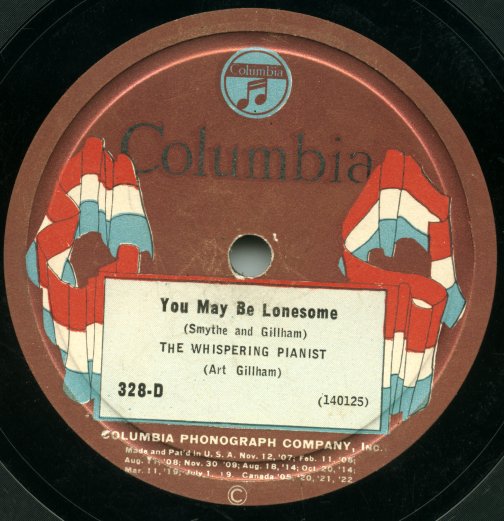
source: Wikipedia, Columbia Flag label of the first Western Electric master to be released – Art Gillham’s own composition “You May Be Lonesome”. Recorded February 25, 1925. Public Domain.
2.1.5 Victor’s First Issued Commercial Electric Recording (1925) / Victor の最初に市販された電気録音
Columbia に遅れること数日、同じく Bell Labs / Western Electric 録音システムのライセンスを受けた Victor が1925年3月16日に 78rpm 用に行った録音が、市販された世界最初の電気録音レコード Victor 19626 で、1925年4月にはフィラデルフィアですでに店頭に並んでいたということのようです。
Days after the Columbia’s first commercial electric recording was made, Victor made the electrical recording with the same Bell Labs / Western Electric system, on March 16, 1925. The record, Victor 19626, was in the Philadelphia record shops in April.
ただ、Victor も Columbia も、リリース直後から電気録音リリースを大々的に宣伝したわけではなかったようです。どうやら、既に市場に出回っているアコースティック録音のレコードが売れなくなることを鑑み、しばらく宣伝をしなかったということのようです。
Interestingly enough, the electrical process and its releases were NOT fully advertised soon after the release – neither by Victor nor Columbia – because if it was, many stocks of acoustical recorded discs already in the market would not sell well. They did not acknowledge the conversion publicly, to have time to dispose of obsolete stock.
ところが、Victor カナダでは、1925年7月から、フライング気味に V.E. プロセス(どこにも「電気録音」とは書いてないことに注意)の宣伝を始めていたそうです。
On the other hand, Victor’s Canadian branch began advertising the “V.E. process” in July 1925 (note any mention of “electrical recording” was not there).
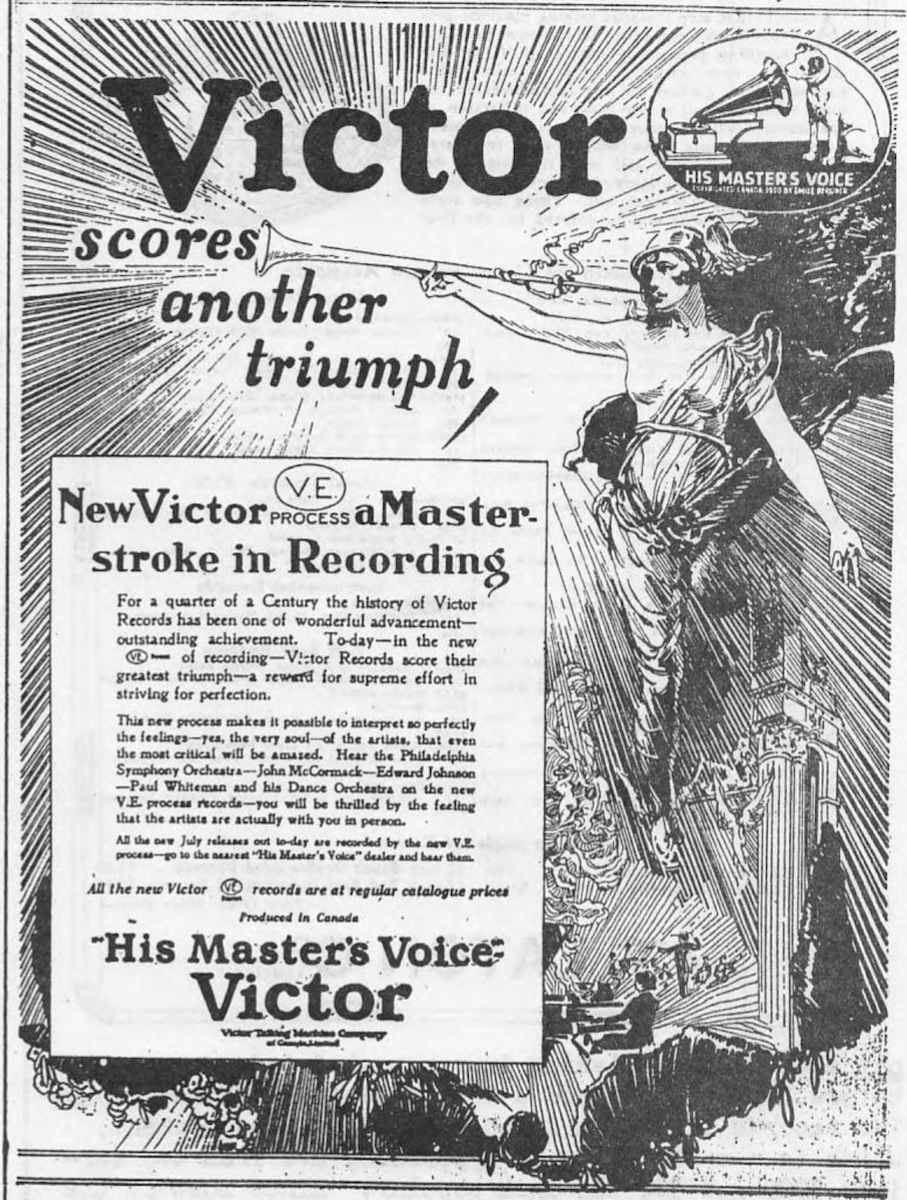
source: “Oh, Canada!”, New Amberola Graphic, p.5, July 1987
フライン気味に1925年7月にカナダで展開された V.E. プロセスの広告
V.E. process Ad, advertised in Canada, July 1925
米国において、電気録音であることが大々的に宣伝されだしたのは1926年あたりと言われていますが、その直前、Talking Machine World 1925年10月15日号において、Victor のディーラーが9月に「電気録音」と説明した、というレポートが掲載されていました。
It was probably in 1926 when Victor (and Columbia) began advertising with the word “electrical process”, but according to the report on the Talking Machine World Oct. 15, 1925 issue, A person of Victor dealer advertised “the new electric process of recording records” in September 1925.
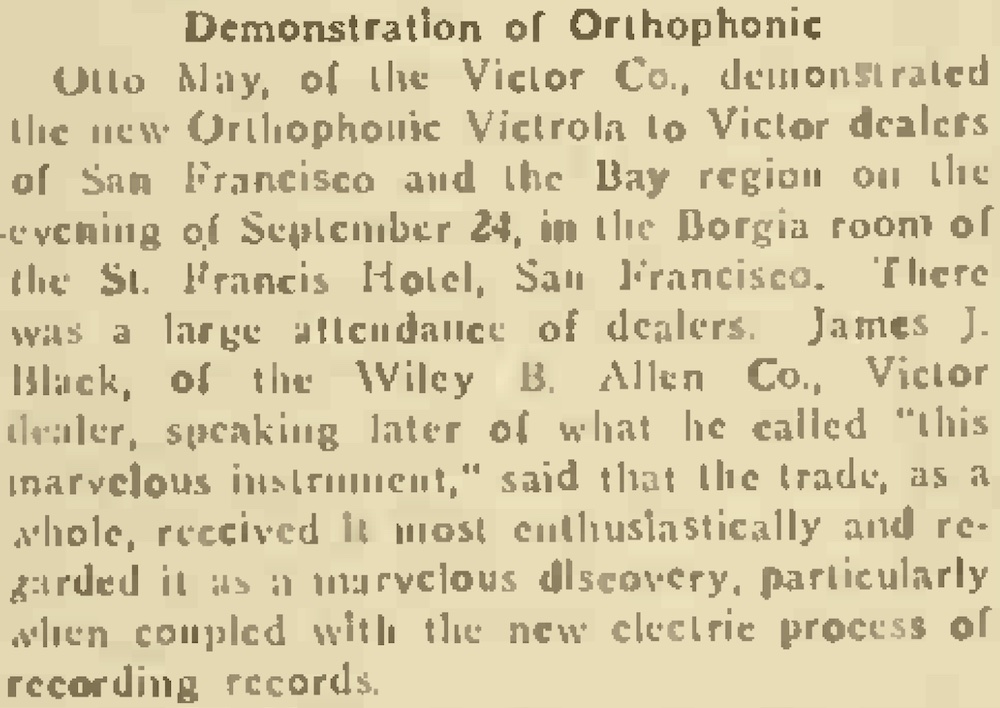
source: “Demonstration of Orthophonic”, The Talking Machine World, October 15, 1925”, p.86.
Victrola デモの際「新しい電気録音によるレコードを再生すると特に素晴らしい」と言った、と掲載
“…particularly when coupled with the new electric process of recording records”
2.2 World’s First Electric Phonograph Player / 世界初の電蓄
本稿 Pt.1 では、Bell Labs / Western Electric からライセンスを受けたシステムを使って録音されたレコードの再生装置として、特別に設計されたアコースティック蓄音機 “Victrola 8-30 Credenza” が用意された話を書きました。
On the Pt.1 of my entire articles, I mentioned the acoustic phonograph “Victrola 8-30 Credenza”, specially developed/crafted for electrical recorded phonographs that were made using the electrical recording system licensed by Bell Labs / Western Electric.
では、最初の電気再生システム、通称「電蓄」は、いつ誕生したのでしょうか。
So the new question arises – when the world’s first Electrical reproducer was born?
2.2.1 Brunswick “Panatrope”
いろいろ調べてみると、最初に登場した電蓄は Brunswick 社の Panatrope というもので、それに対応するレコードは「研究段階では片面40分再生可能」と謳われ、1925年秋頃から順に全米各地で実機のデモンストレーションを行っていたようです。
From what I have did a brief research, the very first one was “Brunswick Panatrope” – the accompanying electrically recorded phonograph can be played forty minutes in a laboratory level, and the Panatrope reproducer had been frequently demonstrated here and there in the US since the fall of 1925.
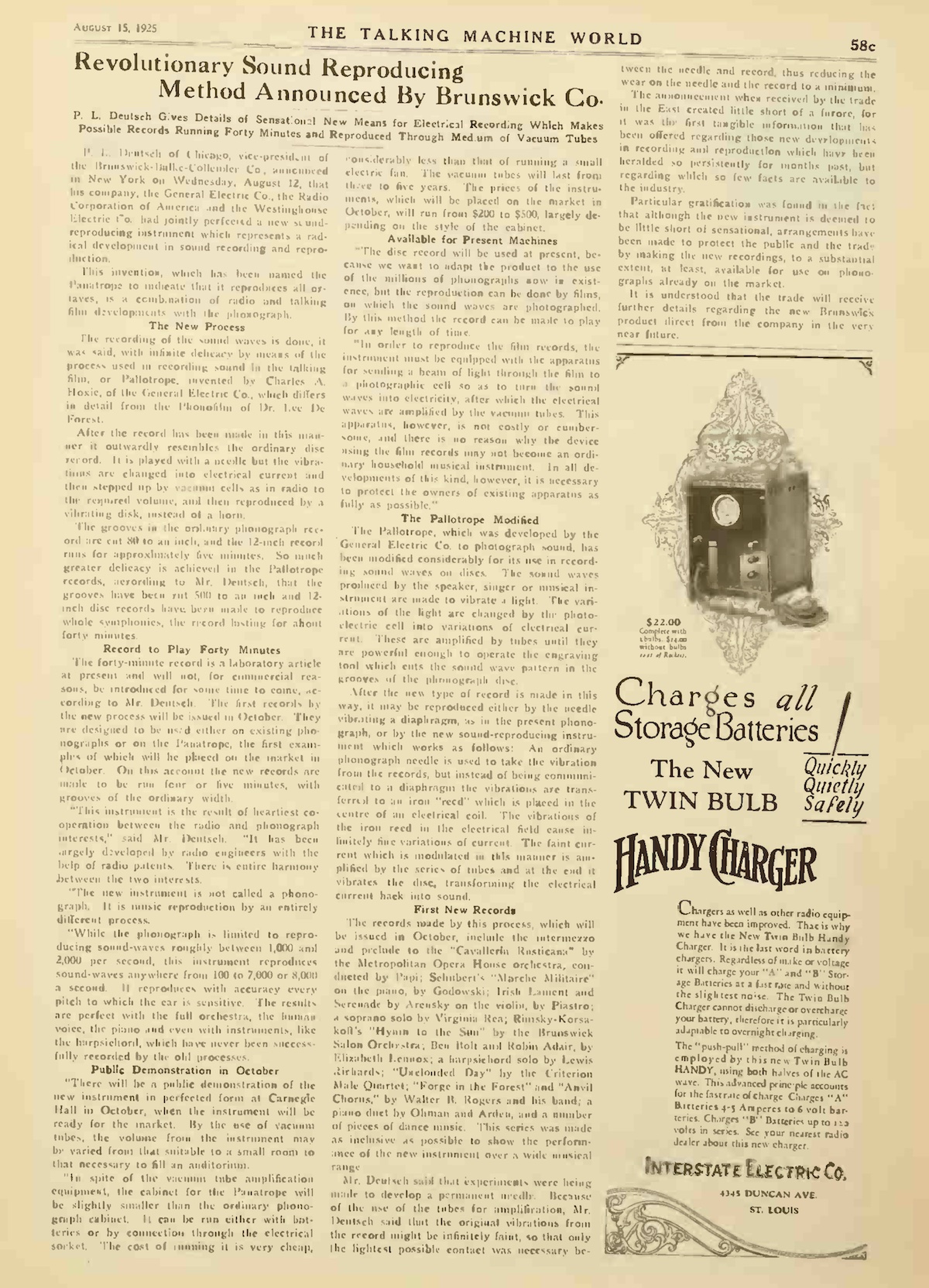
source: “Revolutionary Sound Reproducing Method Announced By Brunswick Co.”, The Talking Machine World, August 15, 1925, p.58c.
The Talking Machine World誌1925年8月号に掲載された記事。これが Brunswick Panatrope の初出と思われ。
Probably the world’s first appearance of Brunswick Panatrope on magazines.
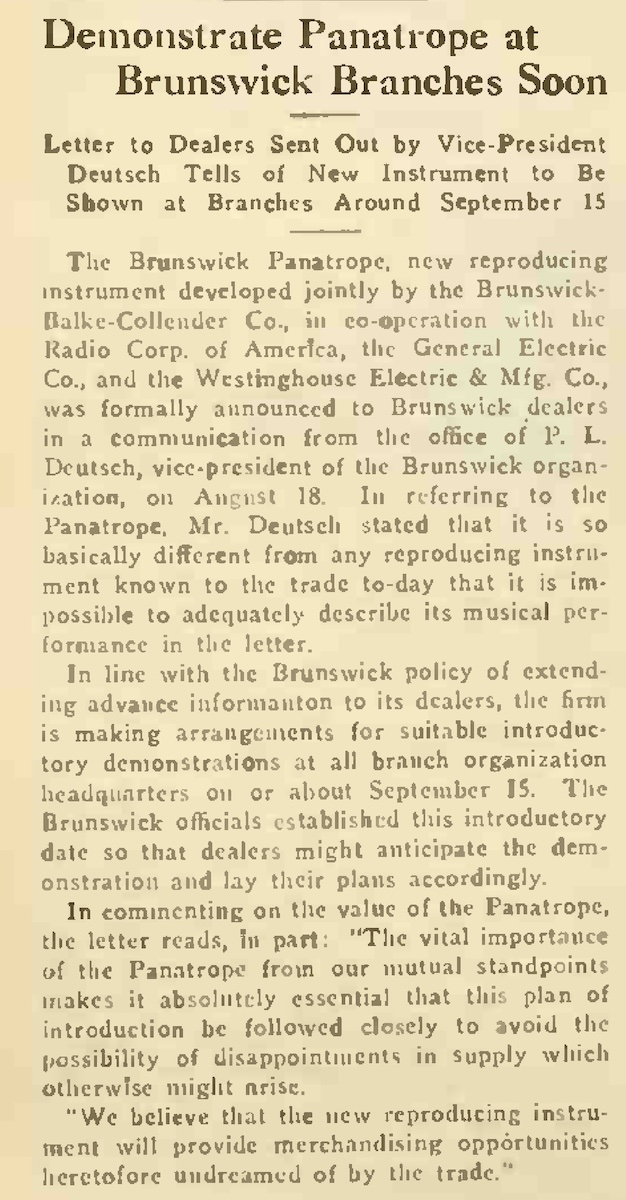
source: “Demonstrate Panatrope at Brunswick Branches Soon”, The Talking Machine World, September 15, 1925, p.3.
The Talking Machine World誌1925年9月号に掲載された記事。9月15日頃開始のデモンストレーションに向け期待が膨らんでいる様子が伺えます。
The second appearance of Panatrope on The Talking Machine World magazine, just before the demonstration on or about September 15.
The Billboard 1925年8月22日号の記事 では、従来の蓄音機に比べ格段に良い音で再生でき、さらに、発明者のひとり Ralph H. Townsend 氏による「従来のアコースティック録音に比べて6倍以上の記録密度を達成でき、実験段階では12インチで片面1時間以上再生できる」というコメントに対し「サマーリゾート施設、ホテル、ダンスホールなどで演奏する小規模バンドにとって大きな脅威になるであろう」と書いています。
The short article “Brunswick Invention Alarms Band Bookers”, published in The Billboard Aug. 22, 1925, shares the comment by one of the developers Ralph H. Townsend, “12-inch disk records have been made to reproduce whole symphonies, the record lasting for about 40 minutes” and “It was said by the inventor that records had been produced that would run an hour or more and that experiments are being made to perfect finer grooves to increase the running time of the records”. Then this article concludes like this: “This would seriously cut in on the demand of small orchestras, chiefly for dance purposes, in summer resorts, hotels, dance pavilions and the like.”
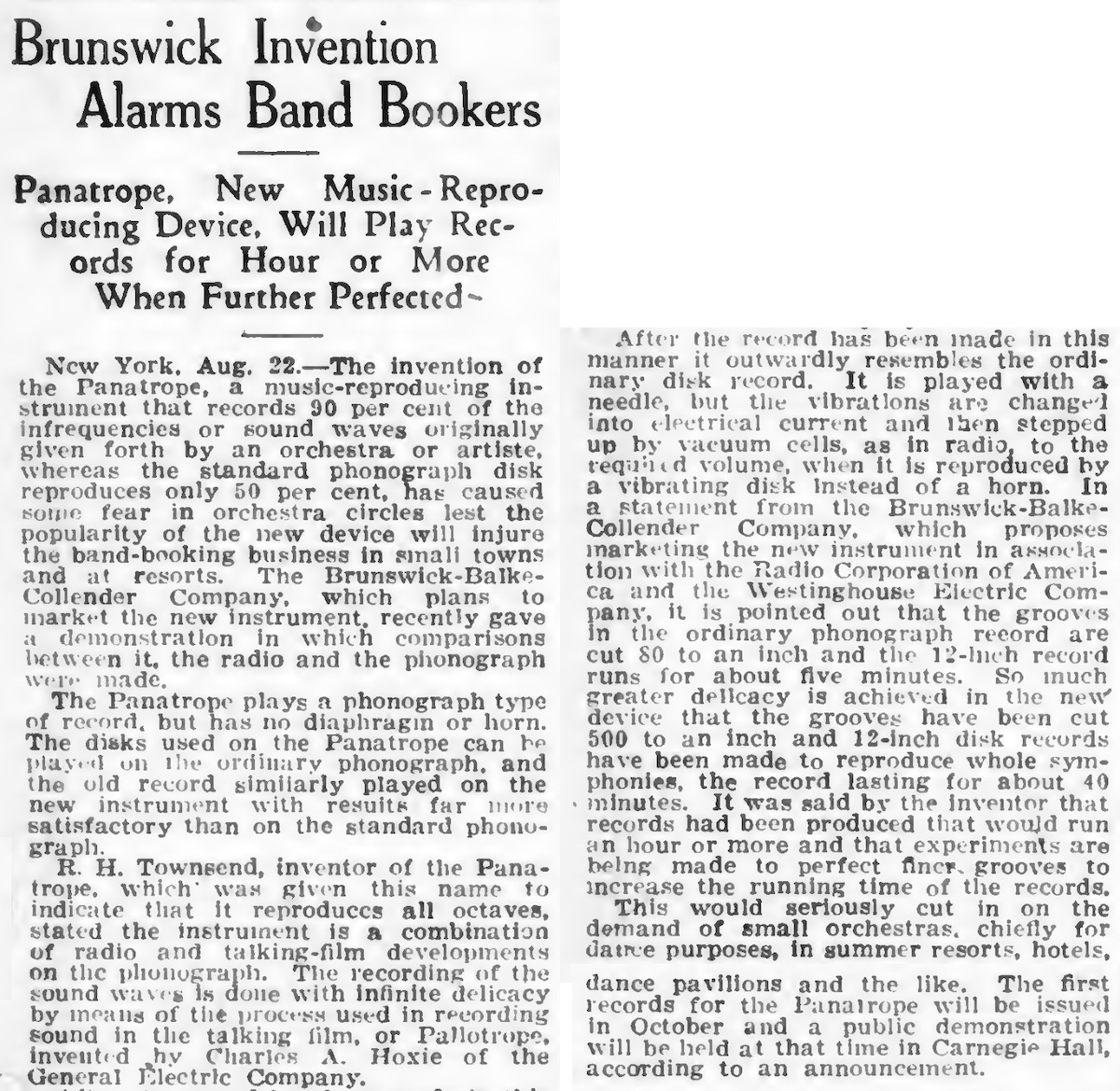
source: “Brunswick Invention Alarms Band Bookers”, The Billboard, p.20, August 22, 1925.
8月22日号の Billbaord 誌にも Panatrope の記事が載っていました
One of the earliest articles of Panatrope, appeared on the August 25, 1925 issue of The Billboard magazine.
さすがにこの時代の技術で片面40分〜1時間を実現、というのは無茶だと思いますが(笑)、それくらい大騒ぎになるほど、新しい技術への期待が高まっていたのでしょう。そしてそれ以上に、宣伝がうまかったということなのでしょう。
However, it would be very questionable that the technology of that time could accomplish forty minutes to one hour of recording on one side of the disc. Anyway, such fanatical news article may suggest that the advanced technology of the newly developed electrical disc recording was felt promising, surprising for many people: in other words, the marketing was really excellent.
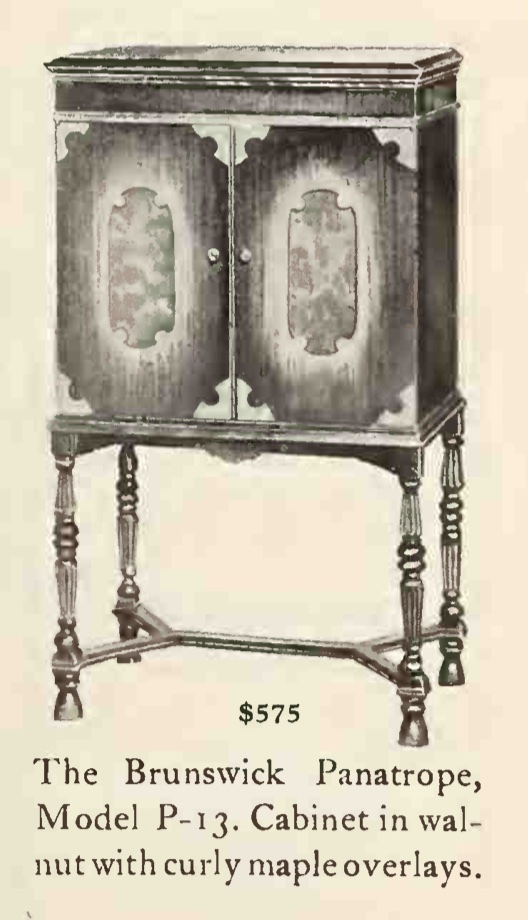
source: Brunswick Ad on “The Talking Machine World, February 15, 1927”, p.5.
The Talking Machine World誌1927年2月15日号に掲載された Brunswick Panatrope P-13 の広告。当時 $575 もしたそうです。
Brunswick Panatrope P-13 Ad on The Talking Machine World magazine, Feb. 15, 1927 – costed $575 at that time.
2.2.2 Victor “Electrola” and Columbia “Kolster”
その他、少し遅れて発表された電蓄には、Columbia 社の Kolster、Victor Talking Machine 社の Electrola などがあったようです。これら両社は、Bell Labs / Western Electric 社製の録音システムをライセンスし使用していたので、その録音特性に合わせて製造されたものということになります。
Shortly after the Brunswick Panatrope, several Electrical Phonograph players came into the market, like Columbia’s Kolster and Victor Talking Machine’s Electrola. Both Columbia and Victor used the recording equipments that were licended from Bell Labs / Western Electric, so these reproducing instruments were made for the Electrically recorded discs that were cut with Bell Labs / Western Electric system.
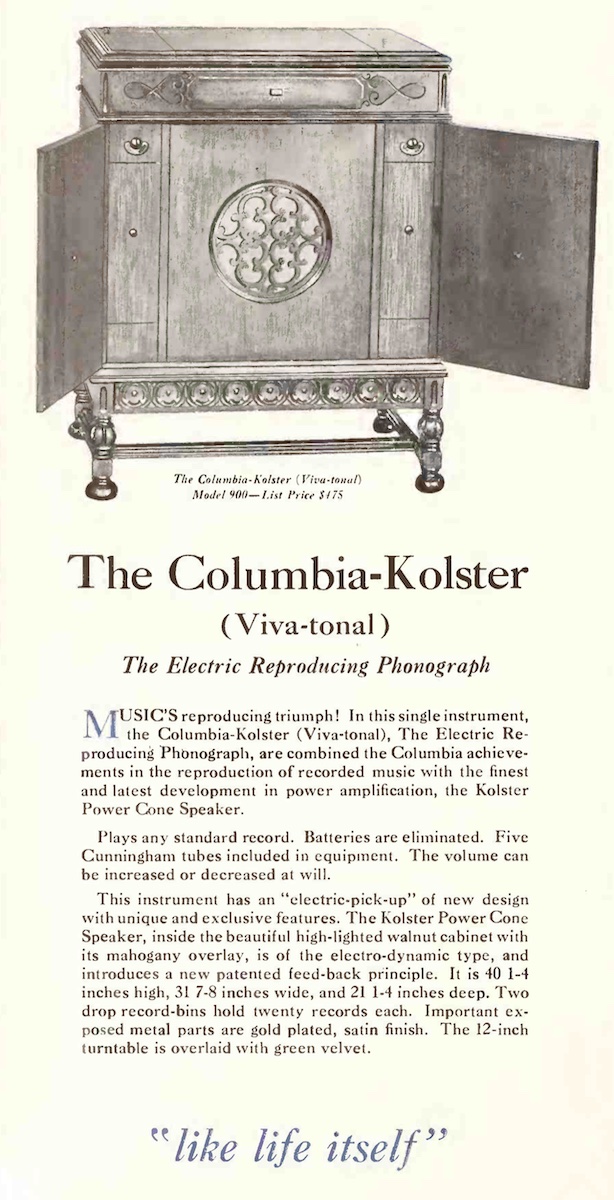
source: Columbia Ad on “The Talking Machine World, December 1927”.

source: “Victor Co. Announces New 1927-8 Electrola and Radio Combination Instruments”, The Talking Machine World, August 1927, p.128.
2.3 “Light-Ray” Electrical Recording Method / Light-Ray 電気録音
で、世界初の電蓄 Brunswick 社の Panatrope も、Bell Labs / Western Electric の電気録音レコード再生用に作られたのかというと、そうではありませんでした。
So, did the world’s first electrical phonograph reproducer Brunswick Panatrope aimed for reproducing electrically recorded discs made with the Bell Labs / Western Electric system? The truth was no.
なんと、Brunswick 社と General Electric 社による独自の録音技術、“Light-Ray” によって作られたレコード向けだったのです。正確には「録音技術」というよりは「マイク技術」と呼ぶべきかもしれません。詳しくは “Victrola and 78 Journal, Issue 13, Autumn 1998” の記事 “Brunswick’s Light-Ray and Panatrope Era – and Beyond” にまとめられていますので、一読をお勧めします。
As a matter of fact, Brunswick (and General Electric) had its own recording technology and instruments, named “Light-Ray”, although we should better call it “transmitter (microphone) technology” rather than “recording technology”. You can read all the details about Brunswick’s Light-Ray process (and the discs) on the article “Brunswick’s Light-Ray and Panatrope Era – and Beyond”, appeared on Victrola and 78 Journal, Issue 13, Autumn 1998.
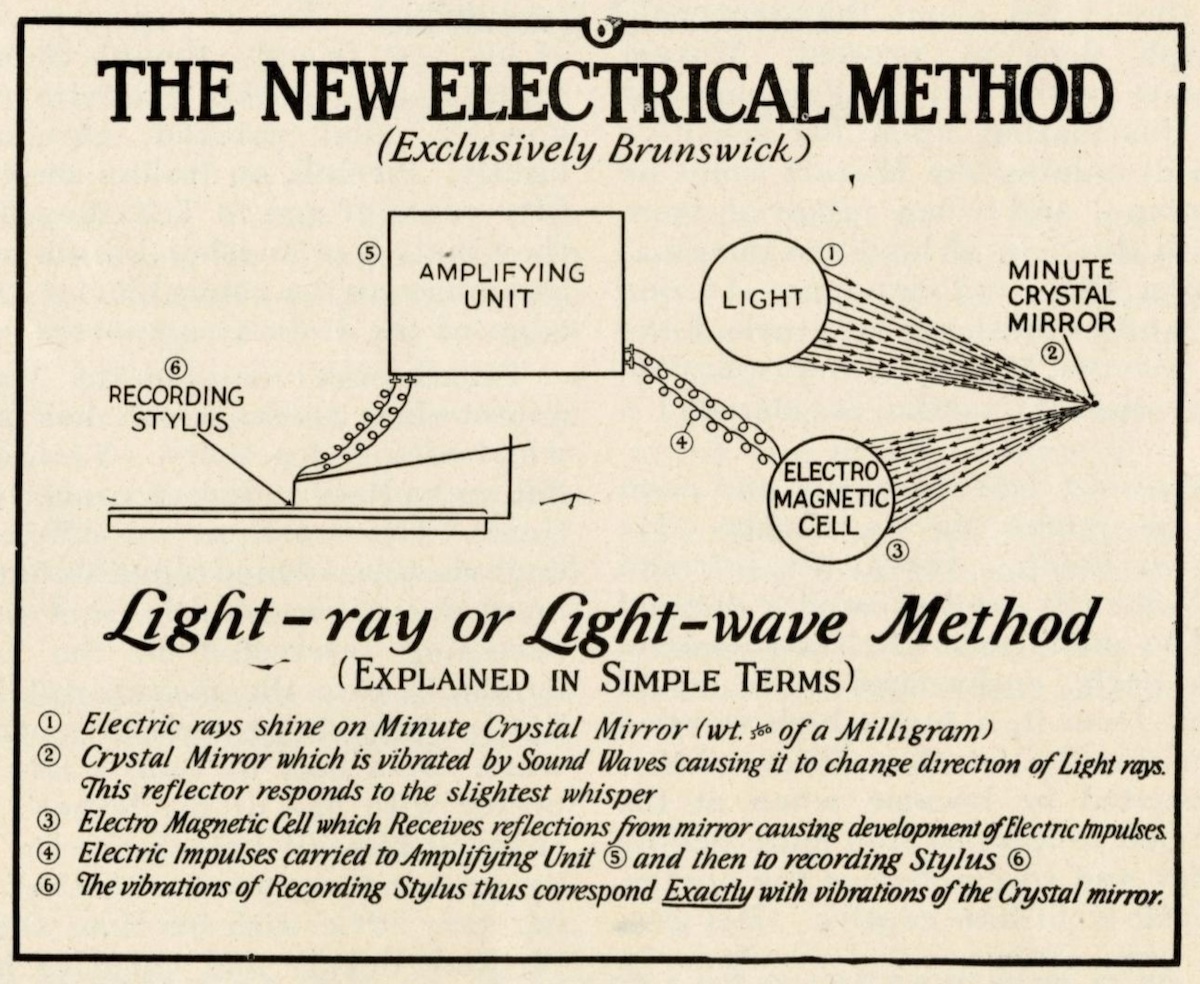
source: “Brunswick Electrical Recording ”, Elmer C. Nelson, The Phonograph Monthly Review, Vol.1; No.1, pp..19-21, October 1926.
The Phonograph Monthly Review 誌創刊号に掲載された、Light-Ray の解説イラスト
The illustration that describes the “Light-Ray” recording process, as shown on the first issue of The Phonograph Monthly Review in Oct. 1926.
During the “Light-Ray” recording process, a powerful beam of light was reflected to a phonoelectric cell by a tiny crystal mirror mounted in a way so it responded to minute vibrations in sound waves. Movements of the mirror were translated into electrical energy by the photoelectric cell, then amplified by the recording equipment, and finally converted into mechanical energy for engraving a phonograph record. The basic patent for this complicated method of recording is #1,598,377.
この「Light-Ray」録音プロセスにおいて、強力な光が微細なクリスタルミラーから反射し、光電素子に到達する。このクリスタルミラーは空気の振動である音にあわせて動き、ミラーの振動が光電素子によって電気エネルギーの変化に変換される。それが録音機器によって増幅され、最終的にレコードに溝を刻む力学的エネルギーに変換される。この複雑な録音手法の基本特許は #1,598,377 である。
“Brunswick's Light-Ray and Panatrope Era--and Beyond”, R.J. Wakeman with Tim Gracyk, pp.1-22, Victrola and 78 Journal, Issue 13, Autumn 1998
source: “1,598,377. RECORDING SOUND, Charles A. Hoxie”, p.1180, Official Gazette of the United States Patent Office, Vol. 349, August 1926.
Light-Ray 録音技術の基礎となる、発明者 Hoxie 氏 (General Electric) の特許。
Brunswick 社によって大々的に喧伝された Light-Ray プロセスと Palatrope 録音システム、そして Panatrope 電蓄でしたが、実際にはいろいろ問題もあったようです。「Light-Rayメソッドを使えば16Hz〜21,000Hzまで記録できるようになる」や「全帯域において歪みなくナチュラルに再生可能、これは誇張ではない」といった宣伝文句とは裏腹に、上述の Wakeman-Gracyk の記事によると、1925年当時の Brunswick/Vocalion の録音の多くでディストーションが目立ったそうです。やっぱりじゃっかん誇大広告気味だったんですね(笑)
Brunswick’s “Light-Ray” process, the recording instrument “Palatrope”, and the reproducing instrument “Panatrope” were enthusically promoted by company representatives, like “It will record vibrations as low as 16 per second, and as high as 21,000 per second – any audible sound”, “…which reproduces all vibrations of the entire musical range naturally – without exaggeration” etc. However, many Brunswick/Vocalion discs of 1925 produce distorted music, according to the above Wakeman-Gracyk article. So it turned out to be an exaggerated advertisement…
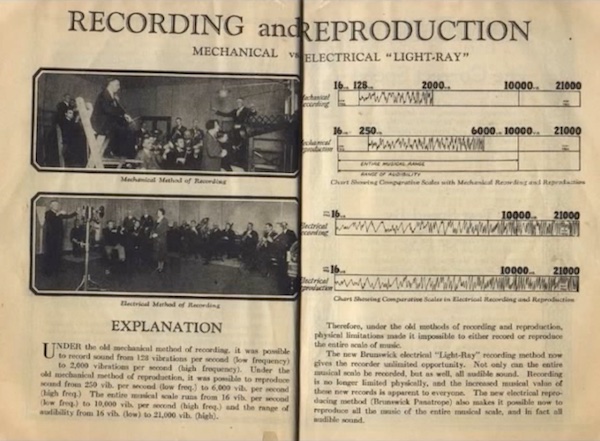
source: YouTube video Brunswick LIGHT RAY Electric Recordings & Deutsche Grammophon 1925. The original source unknown so far.
YouTube映像に登場する記事。オリジナルは現時点では不明。
また、1919〜1927年にBrunswickで録音マネージャであった Walter Gustave “Gus” Haenschen (別名 Carl Fenton) 氏が、1970年代に受けたインタビューが “The James A. Drake Interviews • Walter Gustave (Gus) Haenschen: The Brunswick Years – Part 4 (Conclusion)” に掲載されており、ここでも Light-Ray プロセスについて現場の格闘が生々しく語られています。
There is an invaluable treasure interview with Walter Gustave “Gus” Hoenschen (a.k.a. Carl Fenton), who was Brunswick’s manager of popular recordings from 1919 to June 1927. Part 4 of the entire interview during 1972-1979, “The James A. Drake Interviews • Walter Gustave (Gus) Haenschen: The Brunswick Years – Part 4 (Conclusion)”, features vivid memory of the wresling with the troublesome Light-Ray recording technique.
That process was so unpredictable that we were having to call the performers back to record another “take” of the same performance, hoping that the thing might work this time. We were spending so much time calling back the performers for more “takes” — and in any business, time is money, so we junked that “light ray” thing and made a deal with Western Electric to be able to use their process instead. Back then, it was possible to make confidential deals like that and have them stay confidential. Anyway, from then on the sound quality of our recordings was on a par with Victor’s.
(Light-ray 録音プロセスは非常に不安定だったため) あまりに予測不能であり、そのため、演奏者を何度も呼び戻して同じ演奏をもう1テイク録音してもらい、今度こそうまくいきますように、と願うなんてことが頻発した。こんな感じで(満足いく録音ができるまで)何度もテイクを重ね、多くの時間を費やしてしまった。いかなるビジネスの世界でも「時は金なり」であるから、最終的には「Light-ray」録音プロセスを見限り、その後 Western Electric 機材を代わりに使わせてもらえないかWE社と取り引きを行った。当時はこのような極秘取引は可能で、彼ら(WE社)も機密にしていた。ともあれ、WE機材が使えるようになってから、Victor と同等の音質で録音できるようになった。
The James A. Drake Interviews • Walter Gustave (Gus) Haenschen: The Brunswick Years – Part 4 (Conclusion)結局、Brunswick は、1927年8月末頃には Western Electric マイクを使った(Columbia や Victor と同じ)録音技術にシフトしたとのことです。残念ながら Light-ray による録音の特性については情報が全く見つかりませんでした。
Then finally by late August 1927, Brunswick stopped the Light-Ray recording and adopted the Western Electric microphone method, the same one as Columbia and Victor used. It was a pity that I could not find any information on the recording characteristics for the Light-ray recordings.
2.4 Rival forms of media: Radio & Phonograph / ラジオとレコード、メディアの競合
余談ついでにもう1つ、1925年の電気録音は、ラジオ放送という新興メディアによる脅威 によってもたらされたことも忘れてはなりません。
Yet another degression here – we must understand that, the electrical disc recording was born with the inevitable pressure from the emerging media called “Radio”.
ちょうど第一次世界大戦の終了後、1919年10月1日より、ラジオ電波の非軍事利用が解禁され、その後有名な Frank Conrad 氏による 8XK を含め多くの商用ラジオ局が誕生しました。
Effective Oct. 1, 1919, the ban on civilian radio stations was lifted, then many civilian radio stations (including the famous Frank Conrad’s 8XK) started to broadcast programs.
結果、蓄音機より安価なラジオ受信機を買うだけで、アコースティック録音のレコードよりも高音質で、しかも無料で、コンサートやレコード音源を楽しめるようになり、レコードと蓄音機の売り上げは減少していきました。コンサートに行け、レコードと蓄音機を買える経済的に裕福な層だけではなく、安価なラジオ受信機さえあればいくらでも音楽を楽しめるようになったのですから。
As a result, people of lower socioeconomic classes (who couldn’t afford tickets for concerts, who couldn’t afford to buy phonograph players and discs) could buy a cheap radio receiver and enjoy plenty of music of live concerts and disc recordings on the air – with better sound quality than that of acoustically recorded discs played by acoustic phonograph players.
実際、レコードの売り上げは1921年をピークに年々減少していったそうです。
As a matter of fact, after peaking in 1921, record sales declined each year.

source: “Will Radio Craze Affect Our Industry?”, The Talking Machine World, March 15, 1922”, p.8.
The Talking Machine World誌1922年3月号に掲載された、ラジオ放送ブームを懸念する記事

source: “Why Music Broadcasted by Radio Should Not Hurt Sales of Talking Machine and Records”, The Talking Machine World, March 15, 1922”, p.25.
同じ号に掲載された「ラジオで音楽が放送されても、蓄音機やレコードの売上に悪い影響を与えない理由」という記事
結果、蓄音機製造メーカは1922年頃より、手回しアコースティック蓄音機にラジオ受信機を組み込んで販売を始めました。これは電蓄後にも続き、Victor Talking Machine 社は Electrola Radiola、Brunswick 社は Brunswick Radiola といった機種が製造されました。
As a result, Phonograph/Gramophone makers had to combine radio receiver unit with hand cranked acoustic phonograph player. Such “phonograph & radio combination” started in 1922 or so. It continued after the advent of electrical player, including Victor Talking Machine’s Electrola Radiola and Brunswick’s Brunswick Radiola.
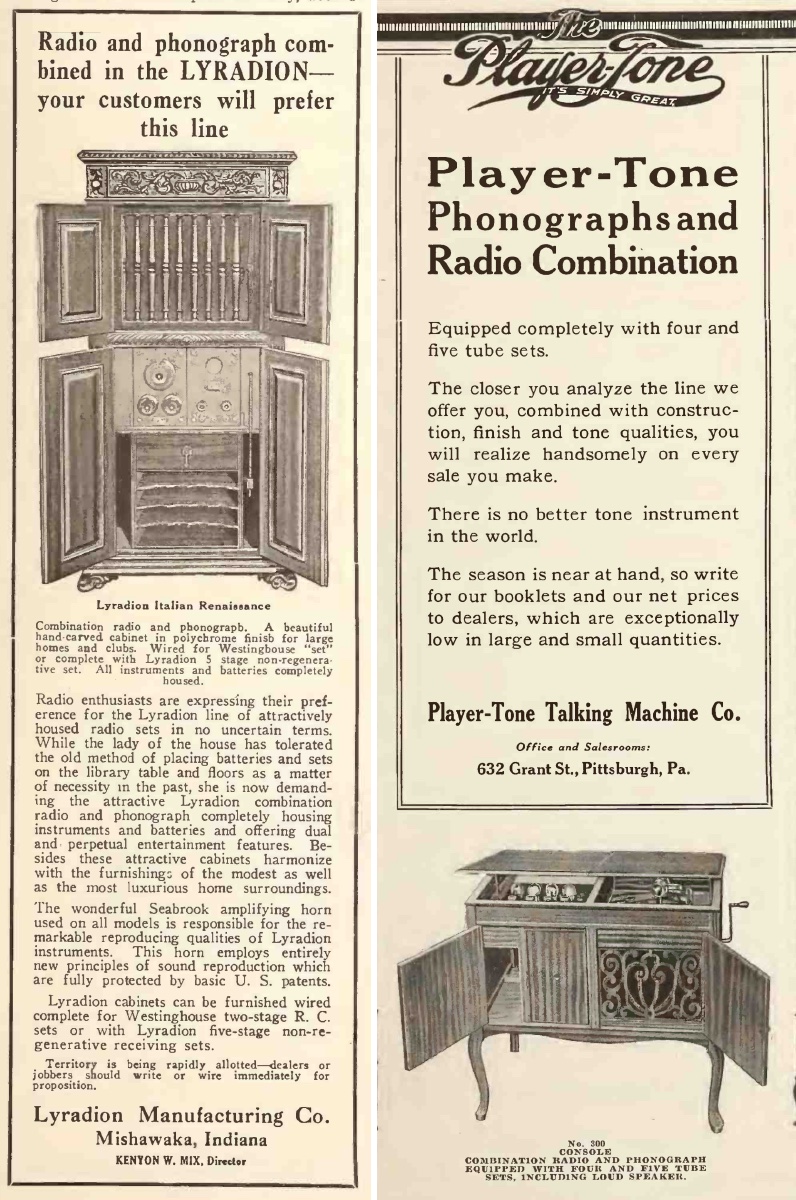
source: Lyradion Italian Renaissance Ad, The Talking Machine World, January 15, 1923, p.79
and Player-Tone No.300 Console Ad, The Talking Machine World, November 15, 1924, p.81
The Talking Machine World 誌に掲載された、アコースティック蓄音機とラジオ受信機の合体モデルの例
つまり、レコードにおける電気録音技術は、ラジオ放送という新しいメディアへの対抗意識から生まれたとも言える、ということですね。ラジオ受信機より高価であっても、レコードと蓄音機には何かアピールできるポイントが必要だった、と。
After all, the invention of Electrical Disc Recording could be the result of “Rival forms of media”. Recorded discs and phonograph players should have some appealing points, although they bing more expensive than radio receivers.
この、ラジオによって蓄音機とレコードが脅かされた時代については、Aaron Hawly 氏が2000年に発表した論文 “Radio’s Influence on Music from 1919 to 1926” の他、Medium 上の長編記事 “History of the Record Industry, 1920— 1950s” に目も眩むほど(笑)詳しく書かれていますので、この当時の歴史について興味のある方は一読をお勧めします。
More detailed story of the era when Radio threatened Phonograph and Disc Records is throughly described in many articles and papers, such as “Radio’s Influence on Music from 1919 to 1926” by Aaron Howly (2000), and “History of the Record Industry, 1920— 1950s”, an excellent article on Medium, both of which are outstanding, and well worth reading for those who are interested in such history.
2.5 The summary of what I got this time / 自分なりのまとめ
今回も予想以上に長くなってしまいました(笑)。電気録音黎明期のあれこれ、Brunswick Light-ray 録音、およびラジオの脅威の時代について書きました。
Well, in this Part 2 article (again, it became a way longer than I initially intended…), I have learned so many things about some other things in the very early electrical recording days; Brunswick’s Light-ray recording system; the radio craze affecting phonograph industry.
今回は、録音再生カーブに関する話は出ず仕舞いでしたが、いろいろ歴史の勉強になりました。
There is no new episode regarding recording/reproducing characteristics in this part, but anyway I could learn more of the history.
さてさて、今回の内容をざっくりまとめると、こんな感じでしょうか。
…so, the rough summary of my understanding in this article would be something like this:
1920年におそらく世界初とされる実験的電気録音がロンドンで行われていた。その音源は今でも聴くことができる。
In 1920, probably the world’s first experiment of electrical recording was conducted in London. The recorded sound still exists, and can be heard on YouTube for example.
独自の Light-Ray / Palatrope 録音システムを開発した Brunswick が自社レーベルに使い始めたが、ほどなくフェードアウトし、Bell Labs / Western Electric のラバーライン録音システムに変更された。
Brunswick developed the unique Light-Ray / Palatrope recording system, and used for their own commercial discs, but after a few years it was replaced by the Bell Labs / Western Electric Rubber-Line recording system.
1919年に始まった民間ラジオ放送は、周波数帯域は当時のレコードより優れており、また受信機も非常に安価だったため、レコードや蓄音機の売り上げは落ち、各メーカやレーベルは受難の時期を過ごした。その危機感から生まれたのが電気録音であった。また、蓄音機メーカはラジオ受信機を合体させることで売上減に少しでも対処しようとしていた。
Commercial radio broadcast in 1919 changed everything, including the decline of record/player sales. Radio had much better frequency range, and the receiver equipments were much cheaper than the phonograph players. Phonograph companies and record labels tried to survive these tough years. The invention of Electrical disc recording could be one of them. Many phonograph makers added radio receiver unit into the phonograph player system, in order to cope with the sales decline.
次回は引き続き歴史を辿り、大恐慌時代の事情、録音技術の進化、Bell Labs / Western Electric ライセンス回避のための独自録音システム開発などについて学んでいきます。今度は録音カーブに関する話が出てくるはずです(笑)
My next post will feature the continuing history, including the Great Depression years, evolution of recording techniques, invention of non-WE recording system to avoid WE’s patent, etc. It will definitely include some stories regarding recording characteristics, unlike this time 🙂
» 続き / Sequel: “Things I learned on Phono EQ curves, Pt.3” »


